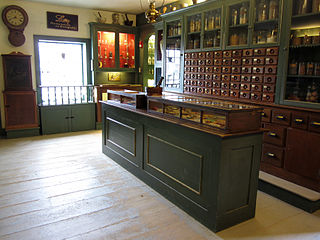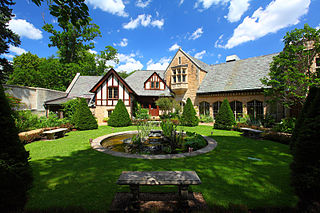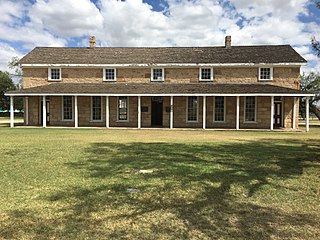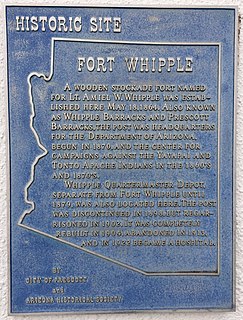 W
WThe Edward H. White II Museum of Aerospace Medicine was a museum of the United States Air Force and was located in Hangar 9 at Brooks Air Force Base, San Antonio, Texas. Brooks Air Force Base closed in 2011 under Base Realignment and Closure Commission (BRAC) procedures, and the museum closed at the same time.
 W
WThe Apothecary Shop is a building at the Shelburne Museum in Shelburne, Vermont, that exhibits objects salvaged from New England pharmacies that were closing in the early decades of the 20th century. The main room contains dried herbs, spices, drugs, and labeled glass apothecary bottles from the nineteenth century, as well as early patent medicines, medical equipment, cosmetics, and a collection of barbers' razors. The compounding room, with its brick hearth, copper distilleries, and percolators, replicates an illustration found in Edward Parrish's 1871 Treatise on Pharmacy.
 W
WThe Army Medical Museum and Library (AMML) of the U.S. Army was a large brick building constructed in 1887 at South B Street and 7th Street, SW, Washington, D.C., which is directly on the National Mall. It was designated a National Historic Landmark in 1965 and added to the National Register of Historic Places in 1966. The building was demolished in 1969, and the collections at the focus of the landmark designation were dispersed.
 W
WThe Bakken is a museum located in Minneapolis, Minnesota, founded in 1975 by Earl Bakken, the co-founder of Medtronic. The exhibits present a concise history and explanation of electricity and electromagnetism.
 W
WThe Carville Historic District in Carville, Louisiana, is a 60-acre (24 ha) historic district that was listed on the National Register of Historic Places on November 18, 1992. It formerly served as a treatment facility for leprosy, and was called the National Leprosarium, Gillis W. Long Hansen's Disease Center and Public Health Service Hospital No. 66.
 W
WCherry Hospital is an inpatient regional referral psychiatric hospital located in Goldsboro, North Carolina, United States. As one of three psychiatric hospitals operated by the North Carolina Department of Health and Human Services, it provides services to 38 counties in the eastern region of North Carolina. It is part of the Division of State Operated Healthcare Facilities within the Department of Health and Human Services, which oversees and manages 14 state-operated healthcare facilities that treat adults and children with mental illness, developmental disabilities, and substance use disorders. The Division's psychiatric hospitals provide comprehensive inpatient mental health services to people with psychiatric illness who cannot be safely treated at a lower level of care.
 W
WChimborazo Hospital was a Civil War-era facility built in Richmond, Virginia to service the medical needs of the Confederate Army. It functioned between 1862 and 1865 in what is now Chimborazo Park, treating over 76,000 injured Confederate soldiers. During its existence, the hospital admitted nearly 78,000 patients and between 6,500 and 8,000 of these patients died. This mortality rate of between 8.3 and 10.3 percent is among the lowest such rates of period military hospitals.
 W
WThe Museum of disABILITY History is a museum related to the history of people with disabilities from medieval times to the present era. Located at 3826 Main Street in Buffalo, New York, USA, it is the only "brick-and-mortar" museum in the United States dedicated exclusively to preserving the history of people with disabilities. The museum seeks to promote a higher level of societal awareness and understanding, and a change in attitudes, perceptions and actions that will result in people with disabilities having the greatest possible participation in their communities.
 W
WThe Dittrick Museum of Medical History is part of the Dittrick Medical History Center of the College of Arts and Sciences of Case Western Reserve University, Cleveland, Ohio. The Dittrick Medical History Center is dedicated to the study of the history of medicine through a collection of rare books, museum artifacts, archives, and images. The museum was established in 1898 by the Cleveland Medical Library Association and today functions as an interdisciplinary study center. It is housed in the Allen Memorial Medical Library on the campus of Case Western Reserve University in Cleveland, Ohio's University Circle.
 W
WThe Drug Enforcement Administration Museum and Visitors Center is a museum owned by the United States Drug Enforcement Administration and located in Arlington, Virginia. Its first exhibit opened in 1999, and features exhibits on cannabis, coca, and poppy.
 W
WThe Dr. Ephraim McDowell House, also known as McDowell House, was a home of medical doctor Ephraim McDowell.
 W
WFort Concho is a former United States Army installation and National Historic Landmark District located in San Angelo, Texas. It was established in November 1867 at the confluence of the North and South Concho Rivers, on the routes of the Butterfield Overland Mail Route and Goodnight–Loving Trail, and was an active military base for the next 22 years. Fort Concho was the principal base of the 4th Cavalry from 1867 to 1875 and then the "Buffalo Soldiers" of the 10th Cavalry from 1875 to 1882. The troops stationed at Fort Concho participated in Ranald S. Mackenzie's 1872 campaign, the Red River War in 1874, and the Victorio Campaign of 1879–1880.
 W
WFort Crawford was an outpost of the United States Army located in Prairie du Chien, Wisconsin, during the 19th century.
 W
WFort Whipple was a United States (U.S.) Army post temporarily established at Del Rio Springs, north of present day Chino Valley, Arizona, by Major Edward Banker Willis and Captain Nathaniel J. Pishon on December 23, 1863. They led Companies C and F of the First California Volunteers and built the post under General Order #27 issued by General James Henry Carleton. The post was named Fort Whipple, after Amiel Weeks Whipple, an American military officer and topographical engineer. He served as a brigadier general in the American Civil War, and was mortally wounded on May 7, 1863 at the Battle of Chancellorsville in Virginia.
 W
WFort Winnebago was a 19th-century fortification of the United States Army located on a hill overlooking the eastern end of the portage between the Fox and Wisconsin Rivers east of present-day Portage, Wisconsin. It was the middle one of three fortifications along the Fox-Wisconsin Waterway that also included Fort Howard in Green Bay, Wisconsin and Fort Crawford in Prairie du Chien, Wisconsin. Fort Winnebago was constructed in 1828 as part of an effort to maintain peace between white settlers and the region's Native American tribes following the Winnebago War of 1827. The fort's location was chosen not only because of its proximity to the site of Red Bird's surrender in the Winnebago War, but also because of the strategic importance of the portage on the Fox-Wisconsin Waterway, a heavily traveled connection between the Great Lakes and the Mississippi River. Fort Winnebago's location near the portage allowed it to regulate transportation between the lakes and the Mississippi.
 W
WThe Fort Winnebago Surgeons Quarters is a historic site in Portage, Wisconsin. Located on the eastern bank of the Fox River, about 1.25 miles from the Wisconsin River, the site contains two historic buildings: the "surgeon's quarters" and Garrison School. The "surgeon's quarters", built circa 1824 at the portage by Francois LeRoi and used as a sutler store, then sold to the US Army as a home for the Fort's surgeon. Garrison School was built circa 1850 near the former Fort property. Both properties are owned, operated, and maintained by the Wisconsin Society Daughters of the American Revolution, which operates it as a historic house museum with 19th century period furnishings and fort artifacts.
 W
WThe Glore Psychiatric Museum is part of a complex of St. Joseph, Missouri, museums, along with the Black Archives Museum, the St. Joseph Museum, and the American Indian and History Galleries. The Glore exhibits feature the 130-year history of the adjacent state mental hospital, and illustrate the history of mental health treatment through the ages. It has been called one of the fifty most unusual museums in the United States.
 W
WThe Harris Dental Museum is a small brick building in the village of Bainbridge in Ross County, Ohio, United States. Built as a residence in 1815, it once housed the first dental school in the United States, and it is now operated as a museum.
 W
WThe Harvard Dental Museum dates from the late 1870s but the exact date of its formation is unknown. The first annual Announcement of The Dental School indicates a museum was in existence, or at least in prospect, in 1868-69. The original specimens in the collection were provided by Dental School Graduates who were required to provide specimens to the Dental Museum to be used as instructional materials for students. Dr. Arthur T. Cabot presented about 175 specimens to the Dental Museum in 1881 and is considered the museum's founder.
 W
WThe John P. McGovern Museum of Health and Medical Science, or The Health Museum in short, is a museum in the Museum District of Houston, Texas. The museum is a member institution of the Texas Medical Center. As of 2012 the museum gets over 180,000 annual visitors, including 22,000 schoolchildren who visit the facility during organized field trips.
 W
WThe Holmes Cottage is a historic house at 521 Main Street in Calais, Maine. Estimated to have been built about 1820, it is the oldest surviving structure in the town, and is notable for its association with Dr. Job Holmes, a leading physician during the community's formative years. The cottage, now owned by the St. Croix Historical Society and operated by them as the Dr. Job Holmes Cottage & Museum, was listed on the National Register of Historic Places in 1988.
 W
WHowe-Waffle House and Medical Museum is an 1889 Queen Anne style home in Santa Ana, California. It was the home of Dr. Willella Howe-Waffle, one of the first female physicians in Orange County, California, until her death in 1924.
 W
WHugh Mercer Apothecary was a pharmacy founded by Hugh Mercer in the mid-18th century. Mercer was a doctor who fled Scotland after the Battle of Culloden. He travelled to Pennsylvania, where he met Colonel George Washington during the French and Indian War and later moved to Fredericksburg, Virginia, on Washington's advice to practice medicine and operate an apothecary.
 W
WThe Independence State Hospital was built in 1873 as the second asylum in the state of Iowa. It is located in Independence, Iowa. The original plan for patients was to relieve crowding from the hospital at Mount Pleasant and to hold alcoholics, geriatrics, drug addicts, mentally ill, and the criminally insane. It was built under the Kirkbride Plan. The hospital's many names include: The Independence Lunatic Asylum, The Independence State Asylum, The Independence Asylum for the Insane, The Iowa State Hospital for the Insane, and The Independence Mental Health Institute. There is also a labyrinth of tunnels which connect every building. Like most asylums of its time, it has had a gruesome and dark history. Remnants of this are the graveyard, hydrotherapy tubs, and lobotomy equipment.
 W
WThe Indiana Medical History Museum is an Indianapolis monument to the beginning of psychiatric medical research. It is located on the grounds of what was formerly Central Indiana Hospital for the Insane, later shortened to Central State Hospital. It was placed on the National Register of Historic Places on April 25, 1972, as the Old Pathology Building.
 W
WThe Lexington History Center once housed several independent history museums in downtown Lexington, Kentucky. It was located in the former Fayette County Courthouse until 2012 when the city closed the building for renovation. Prior to the closing of the building, the Isaac Scott Hathaway Museum moved to a new location on Georgetown Street. The building has since been renovated into a multi-use commercial, tourist, office and event center.
 W
WLloyd Library and Museum is an independent research library located in downtown Cincinnati, Ohio. Its core subject and collection focus is medicinal plants, with emphasis on botany, pharmacy, natural history, alternative medicine, and the history of medicine and science.
 W
WPilgrim Psychiatric Center, formerly known as Pilgrim State Hospital, is a state-run psychiatric hospital located in Brentwood, New York. Nine months after its official opening in 1931,the hospital's patient population was 2,018, as compared with more than 5,000 at the Georgia State Sanitarium in Milledgeville, Ga. At its peak in 1954, Pilgrim State Hospital could claim to be the largest mental hospital in the U.S., with 13,875 patients. Its size has never been exceeded by any other facility, though it is now far smaller than it once was.
 W
WThe McGill Drug Store Museum is a former drug store in McGill, Nevada. It operated from 1915 to 1979. The store closed when the nearby Kennecott Copper mine closed down, with its entire inventory intact, including prescription medication. It has been re-opened as a museum with more than 30,000 items as well as prescription records extending back to 1915. The museum is a resource for investigators of retailing and historical pharmacy practices.
 W
WThe National Museum of Health and Medicine (NMHM) is a museum in Silver Spring, Maryland, near Washington, DC. The museum was founded by U.S. Army Surgeon General William A. Hammond as the Army Medical Museum (AMM) in 1862; it became the NMHM in 1989 and relocated to its present site at the Army's Forest Glen Annex in 2011. An element of the Defense Health Agency (DHA), the NMHM is a member of the National Health Sciences Consortium.
 W
WOregon State Hospital is a public psychiatric hospital in the U.S. state of Oregon, located in the state's capital city of Salem with a smaller satellite campus in Junction City opened in 2014. Founded in 1862 and constructed in the Kirkbride Plan design in 1883, it is the oldest operating psychiatric hospital in the state of Oregon, and one of the oldest continuously operated hospitals on the West Coast.
 W
WPalmer College of Chiropractic is a private chiropractic college with its main campus in Davenport, Iowa. It was established in 1897 by Daniel David Palmer and was the first school of chiropractic in the world. The college's name was originally the Palmer School and Cure and later became the Palmer School of Chiropractic. Most early chiropractic schools were founded by Palmer alumni.
 W
WPsychiatry: An Industry of Death is a museum in Hollywood, Los Angeles, California, US, as well as several touring exhibitions. It is owned and operated by the Citizens Commission on Human Rights (CCHR), an anti-psychiatry organization founded by the Church of Scientology and psychiatrist Thomas Szasz. The museum is located at 6616 Sunset Boulevard, Los Angeles, California and entry to the museum is free.
 W
WThe Captain Enoch Remick House is part of a historic homestead located in the town of Tamworth, New Hampshire, United States. In 1996, the house—along with a complex of five surrounding outbuildings and approximately 69 acres (28 ha) of field, pasture and woodland—was listed on the National Register of Historic Places for its significance in art, architecture, and local agriculture. It now operates under the auspices of the Remick Country Doctor Museum & Farm.
 W
WThe U.S. Army Medical Department Museum — or AMEDD Museum — at Fort Sam Houston, San Antonio, Texas, originated as part of the Army's Field Service School at Carlisle Barracks, Pennsylvania. It moved to Fort Sam Houston in 1946. It is currently a component of the U.S. Army Medical Department Center and School.
 W
WThe Warren Anatomical Museum, housed within Harvard Medical School's Countway Library of Medicine, was founded in 1847 by Harvard professor John Collins Warren, whose personal collection of 160 unusual and instructive anatomical and pathological specimens now forms the nucleus of the museum's 15,000-item collection. The Warren also has objects significant to medical history, such as the inhaler used during the first public demonstration of ether-assisted surgery in 1846 , and the skull of Phineas Gage, who survived a large iron bar being driven through his brain. The museum's first curator was J.B.S. Jackson.